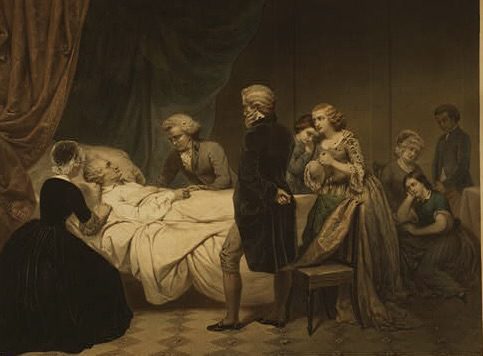Caroline Branham (1764 – March 13, 1843), enslaved at Mount Vernon and later at Arlington House, is buried in an unmarked grave at Christ Church without a gravestone. Arlington House was built and owned by George Washington Parke Custis (April 30, 1781 – October 10, 1857). Caroline served as the chambermaid to Martha Dandridge Washington (June 1, 1731 – May 22, 1801) and was willed to Custis after Martha died in 1801.
Duties at Mount Vernon
According to the official website of Mount Vernon, “Caroline, along with Molly, Charlotte, and other enslaved housemaids, were subjected to a constant cycle of domestic chores. These included lighting fires, making beds, washing clothes and linens, sweeping and scrubbing floors, and dusting furniture, among many other tasks. George Washington expected them to remain productive even outside their household duties. Additionally, Branham’s skills extended to sewing, as she made household linens and clothing such as shirts and shifts for her fellow enslaved workers.”
The Death of General Washington
Caroline’s daily responsibilities included lighting the fire in General George Washington’s bedchamber at dawn. On December 14, 1799, she found that Washington was ill. Following Martha’s instructions, she summoned Washington’s secretary, Tobias Lear, and he, in turn, sent for the doctors. Caroline remained with Washington throughout the day and was present when he died later that evening.

An illustration from the 1853 lithograph “Life of George Washington: The Christian” by Claude Regnier, after Junius Brutus Stearns, captures George Washington’s final moments. Surrounding him were not only Martha, Dr. James Craik, Tobias Lear, and his valet, Christopher Shears, but also three enslaved household maids known to history: Caroline, Molly, and Charlotte—image courtesy of the Library of Congress.
Caroline was married to Peter Hardiman, who was also enslaved but owned by David Stuart (August 3, 1753 – October 1814). Washington rented Peter for 12 years, during which he served as a groomsman. Stuart, a friend of Washington, was appointed by him as one of three commissioners to the new United States Capital city. He also married Elenor Calvert Custis (1757/1758 – September 28, 1811), the widow of Washington’s stepson, John Parke Custis, who died during the 1781 Yorktown Campaign. Elenor was the mother of George Washington Parke Custis, known as “Washy,” who grew up at Mount Vernon and moved with Washington to New York and Philadelphia during his presidency. Caroline and Peter had eight children: Wilson, Rachael, Jemima, Leanthe, Polly, Peter, Austin, and Daniel.
Inherited by George Washington Parke Custis
Following Martha’s death in 1802, Caroline was inherited by Custis and began working at Arlington. There, she had a daughter named Lucy, who bore a resemblance to Custis’s daughter, Mary Anna Randolph Custis Lee (October 1, 1807 – November 5, 1873). Mary Anna was the wife of Robert E. Lee (January 19, 1807 – October 12, 1870).
Her account of Washinton’s Death
Mary Gregory Powell, who is buried in the Presbyterian Cemetery, noted that when Caroline was living at Arlington, author Jared Sparks (1789 – 1866) visited the estate in the late 1820s. He was gathering information for his book “The Life of George Washington.” Mr. Custis brought him to Caroline’s cabin and promised her that if she provided a clear account of Washington’s death scene, her grandson Robert Robinson would be granted freedom. Caroline’s recollection was so vivid despite her age that Robert received his freedom papers. He was then sent to school in Georgetown and apprenticed to Andrew Jamison (buried in The Presbyterian Cemetery) at his cracker factory. According to Powell, Robert Henry Robinson (March 14, 1824 – November 22, 1909) became a minister and preached at the Methodist Church on South Washington Street. He is buried in Bethel Cemetery, Wilkes Street Complex.
Upon Caroline’s death in 1843, Custis arranged her burial in Christ Church Cemetery.
George Washington’s Mount Vernon’s official website, which includes information about Branham, states in a footnote that she is buried in the old Christ Church burial ground. However, sources like Find-A-Grave suggest Branham’s burial site is in the Christ Church Cemetery on Wilkes Street. This aligns with historical context, as council orders ceased burials within Alexandria on May 1, 1809. While the council occasionally authorized interments within town limits—such as Dr. James Muir, Pastor of the Presbyterian Meeting House, who was buried 13 feet beneath the sanctuary floor in 1820—such burials were exceptions rather than standard practice.
Sources of Information
Pippenger, Wesley E. Tombstone Inscriptions of Alexandria, VA (Volume 3). Family Line Publications. Westminster, Maryland. 1992
Powell, Mary Gregory. Index by Pippenger, Wesley E. The History of Old Alexandria, VA, from July 13, 1749 – May 24, 1861. Westminster, Maryland, Willow Bend Books. 2000.
Clark, Charles S. George Washington Parke Custis. A Rarefied Life in America’s First Family. McFarland & Company, Inc. Jefferson, North Carolina. 2021.
The official site of George Washington’s Mount Vernon and a page on Caroline Branham [Link]. It was accessed in 2023.
From the above Lucy, (Caroline’s daughter) father could have been George Washington Parke Custis
Russell – I read that elsewhere, too. Thanks for pointing that out!